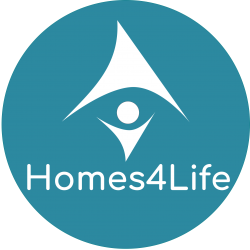Homes4Life Deliverable D2.4 & D3.1 – Working Taxonomy & KPI Framework for Smart age friendly living environments – is now available for download.

Executive Summary
The Homes4Life project has posited for itself an ambitious set of targets. It aims to stimulate investment in age-friendly homes and improve opportunities for ageing well in place for the European population, by both defining and offering a holistic, positively framed long- term vision for inclusive housing in Europe, and offering practical tools in the form of certification. To unite those two workstreams into a coherent whole that will support stakeholders to understand one another, work together and find common ground for action, tools are needed to bridge the gap and facilitate the transition between long-term vision and current practice.
The Homes4Life has accordingly set itself the task to develop two instruments for this purpose: a working taxonomy, and a framework of Key Performance Indicators (KPIs).
The working taxonomy of age-friendly homes (D2.4) presents a structured and detailed breakdown of what it means for a home to be age-friendly? Which functions does the home environment have to fulfil? Which elements in its location, setting, design, construction and components contribute to its fitness for purpose? Which stakeholder groups are in some way involved with the age-friendly home environment and what do they need and want from the home in order for it to be fit for their social, practical or economic purpose? The working taxonomy is a first attempt to answer these questions in a structured way. In doing so, it aims to fill an evident gap in current understanding of and discussions around age-friendly homes: the lack of basic shared descriptive language for academic and practical discourse. This lack of a common reference framework hinders efforts to improve the age-friendliness of the European stock of homes: without a usable framework it is very hard to identify which problems to tackle, which intervention strategies are likely to work, and/or how to incentivize improvements appropriately.
The development of the working taxonomy has been shaped by three main objectives. In terms of agenda-setting, work on the taxonomy has sought to redefine the terms “smart” and “integrated” from the narrow ICT-sense in which they are currently applied to the home environment. Work on the taxonomy has sought to demonstrate that “smart” can be more usefully understood in a teleological sense as the extent to which a home contributes to the personal and organisational aspirations of its occupants and other stakeholders and can adapt as these change over time. “Integrated”, likewise, should be construed more broadly as describing how well a home is embedded in its spatial and social context, and the extent to which it helps its occupants to maintain existing social networks and build new connections. Conceptually, the goal of the taxonomy is to address a number of specific current gaps in understanding of and approaches to age- friendly homes. Practically, and most importantly for a working instrument, the taxonomy sets itself the task to develop a reference framework that works to support and tie together the Homes4Life project objectives.
Taking its inspiration from academic research in salutogenesis, place making and gerontechnology, as well as from policy-based and monitoring approaches developed by the World Health Organisation (Age-friendly Cities, and Age-friendly Environments in Europe), UNECE and the European Commission (Active Ageing Index) and the European Innovation Partnership on Active and Healthy Ageing (Monitoring and Assessment Framework for the EIP AHA), as well as promising work in recent EU-funded projects, the working taxonomy has been shaped as a matrix in which an itinerary of user and other stakeholder perspectives on one axis is matched with a detailed breakdown of the homeenvironment’s main functions on the other. These functions have been broken down into five main clusters: Physical functions of the home, functions concerning Outdoor Access, Personal functions, Social functions, and Economic functions and aspects. After consideration of several other structuring principles, this perspectives and functions driven approach has been considered to fit best with the practical utility required of the taxonomy, which consisted in the following aspects:
- Create a common language, focusing on the universalities rather than the context- specific particularities of age-friendly homes
- Clarify who are the stakeholders involved in age-friendly homes and help identify their needs and concerns.
- Help stakeholders to understand and appreciate each other’s viewpoints and find common ground
- Give a full view of the functions the home environment fulfils for its various stakeholders, taking especial care to move beyond the relatively narrow domain
- Support the adoption of a positive, value-based approach to ageing in place
- Present a comprehensive overview, yet be flexible enough to allow description, analysis and assessment in specific contexts and projects.The report outlines the results of the development process of the working taxonomy. It also showcases a first test that has been done to get an idea of the actual utility of the working taxonomy as a canvas to map meanings, impacts and priorities: the definition of a set of what have been called Needs or Preferences (NoPs), which have been defined using the taxonomy descriptive framework. A total of 150 NoPs have been identified in this initial exercise. Both the working taxonomy and the outcomes of this initial verification exercise are presented in the report.
The report also details the development process and contents of the KPI-framework (D3.1). The decision to combine the two into a single report has been a conscious one. The development of working taxonomy and KPI-framework has constituted one integrated workstream. More importantly, the KPI-framework uses the taxonomy as its structuring principle and could not be easily understood without it. Finally, working taxonomy and KPI- framework are two connected practical tools to support the Homes4Life objectives, so it makes sense to create a single locus where those interested can find information.
What does a home actually have to do in order to be age-friendly? That is the central question that the Homes4Life KPI-framework sets out to answer. The KPI-framework represents the follow-on step in the transition from vision-based, high-level concepts to a comprehensive, “universal” (that is, not implementation context dependent) set of indicators that can form the basis for more specific requirement-setting and verification in the certification pilots in Work Package 4.
While called KPIs, the indicators developed for Homes4Life are better understood as Functional Performance Indicators (FPIs). They describe what a home, its components, its physical characteristics, its lay-out and design, its components, its location and settings, its connections to the outside world, and/or its financial and governance aspects need to be able to do in order to fulfill a Function (as defined in the Homes4Life taxonomy framework) that contributes to the creation or maintenance of an age-friendly environment that is enabling, fit for purpose, flexible and resilient. The KPIs or FPIs in Homes4Life are defined in terms of outcomes achieved and functionality provided for users and other stakeholders. This has been done in accordance with the objective of providing a framework that is relatively context-independent, with it or sections of it being tailored to more specific applications through requirement and verification process and value setting in specific certification application.
In developing the KPI-framework, most effort and ingenuity has been spent on developing indicators for the Functional clusters where current certification schemes, labels, standards and guidelines do not provide adequate answers. For these clusters, the Personal, Social and Economic clusters, an analysis of both academic and policy and advocacy literature has been conducted to identify and collect appropriate KPIs for inclusion. For the Physical and Outdoor Access cluster, full use has been made of the work done earlier in the Homes4Life project on the analysis of existing certification schemes (task 3.2). The material from this analysis has been integrated and condensed with the resulting shorter set of KPIs redefined in terms with the format and purposes of the Homes4Life KPI-framework. In total, 273 KPIs have been described, in a uniform format.
Neither the working taxonomy nor the KPI-framework are to be considered as the final word on the subject. Both represent pragmatic approaches designed to provide a sufficient base for the purposes and continuation of the Homes4Life project. As the project enters its second year, both deliverables will be tested against the demands of certification pilots and subjected to the scrutiny and input of the project’s Community of Interest as well as wider groups of stakeholders. The feedback from practice and from a wide community of interested persons and organizations will serve to further refine, extend and update both instruments, appropriate to their intended status as flexible working tools.

